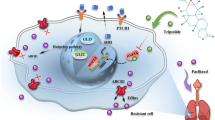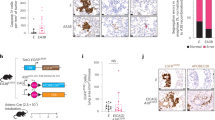Abstract
Development of targeted therapy for hepatocellular carcinoma (HCC) remains a major challenge. We have recently identified an elevated expression of the fifth subunit of COP9 signalosome (CSN5) in early HCC as compared with dysplastic stage. In the present study, we explored the possibility of CSN5 being a potential therapeutic target for HCC. Our results show that CSN5 knockdown by small-interfering (si) RNA caused a strong induction of apoptosis and inhibition of cell-cycle progression in HCC cells in vitro. The down-regulation of CSN5 was sufficient to interfere with CSN function as evidenced by the accumulation of neddylated Cullin 1 and changes in the protein levels of CSN-controlled substrates SKP2, p53, p27 and nuclear factor-κB, albeit to a different degree depending on the HCC cell line, which could account for the CSN5 knockdown phenotype. The transcriptomic analysis of CSN5 knockdown signature showed that the anti-proliferative effect was driven by a common subset of molecular alterations including down-regulation of cyclin-dependent kinase 6 (CDK6) and integrin β1 (ITGB1), which were functionally interconnected with key oncogenic regulators MYC and TGFβ1 involved in the control of proliferation, apoptotic cell death and HCC progression. Consistent with microarray analysis, western blotting revealed that CSN5 depletion increased phosphorylation of Smad 2/3, key mediators of TGFβ1 signaling, decreased the protein levels of ITGB1, CDK6 and cyclin D1 and caused reduced expression of anti-apoptotic Bcl-2, while elevating the levels of pro-apoptotic Bak. A chemically modified variant of CSN5 siRNA was then selected for in vivo application based on the growth inhibitory effect and minimal induction of unwanted immune response. Systemic delivery of the CSN5 3/8 variant by stable-nucleic-acid-lipid particles significantly suppressed the tumor growth in Huh7-luc+ orthotopic xenograft model. Taken together, these results indicate that CSN5 has a pivotal role in HCC pathogenesis and maybe an attractive molecular target for systemic HCC therapy.
This is a preview of subscription content, access via your institution
Access options
Subscribe to this journal
Receive 50 print issues and online access
$259.00 per year
only $5.18 per issue
Buy this article
- Purchase on Springer Link
- Instant access to full article PDF
Prices may be subject to local taxes which are calculated during checkout






Similar content being viewed by others
Accession codes
References
Adler AS, Lin M, Horlings H, Nuyten DS, van de Vijver MJ, Chang HY . (2006). Genetic regulators of large-scale transcriptional signatures in cancer. Nat Genet 38: 421–430.
Adler AS, Littlepage LE, Lin M, Kawahara TL, Wong DJ, Werb Z et al. (2008). CSN5 isopeptidase activity links COP9 signalosome activation to breast cancer progression. Cancer Res 68: 506–515.
Arsura M, Cavin LG . (2005). Nuclear factor-kappaB and liver carcinogenesis. Cancer Lett 229: 157–169.
Avila MA, Berasain C, Torres L, Martín-Duce A, Corrales FJ, Yang H et al. (2000). Reduced mRNA abundance of the main enzymes involved in methionine metabolism in human liver cirrhosis and hepatocellular carcinoma. J Hepatol 33: 907–914.
Bae MK, Ahn MY, Jeong JW, Bae MH, Lee YM, Bae SK et al. (2002). Jab1 interacts directly with HIF-1alpha and regulates its stability. J Biol Chem 277: 9–12.
Bashir T, Dorrello NV, Amador V, Guardavaccaro D, Pagano M . (2004). Control of the SCF(Skp2-Cks1) ubiquitin ligase by the APC/C(Cdh1) ubiquitin ligase. Nature 428: 190–193.
Berasain C, Herrero JI, García-Trevijano ER, Avila MA, Esteban JI, Mato JM et al. (2003). Expression of Wilms’ tumor suppressor in the liver with cirrhosis: relation to hepatocyte nuclear factor 4 and hepatocellular function. Hepatology 38: 148–157.
Brasse D, Mathelin C, Leroux K, Chenard MP, Blaise S, Stoll I et al. (2010). Matrix metalloproteinase 11/stromelysin-3 exerts both activator and repressor functions during the hematogenous metastatic process in mice. Int J Cancer 127: 1347–1355.
Bruix J, Sherman M . (2005). Management of hepatocellular carcinoma. Hepatology 42: 1208–1236.
Bumcrot D, Manoharan M, Koteliansky V, Sah DWY . (2006). RNAi therapeutics: a potential new class of pharmaceutical drugs. Nat Chem Biol 2: 711–719.
Chamovitz DA . (2009). Revisiting the COP9 signalosome as a transcriptional regulator. EMBO Rep 10: 352–358.
Claret FX, Hibi M, Dhut S, Toda T, Karin M . (1996). A new group of conserved coactivators that increase the specificity of AP-1 transcription factors. Nature 383: 453–457.
Elbashir SM, Harborth J, Lendeckel W, Yalcin A, Weber K, Tuschl T . (2001). Duplexes of 21-nucleotide RNAs mediate RNA interference in cultured mammalian cells. Nature 411: 494–498.
Esteva FJ, Sahin AA, Rassidakis GZ, Yuan LX, Smith TL, Yang Y et al. (2003). Jun activation domain binding protein 1 expression is associated with low p27(Kip1) levels in node-negative breast cancer. Clin Cancer Res 9: 5652–5659.
Feitelson MA, Sun B, Satiroglu Tufan NL, Liu J, Pan J, Lian Z et al. (2002). Genetic mechanisms of hepatocarcinogenesis. Oncogene 21: 2593–2604.
Fire A, Xu S, Montgomery MK, Kostas SA, Driver SE, Mello CC . (1998). Potent and specific genetic interference by double stranded RNA in Caenorhabditis elegans. Nature 391: 806–811.
Fukumoto A, Ikeda N, Sho M, Tomoda K, Kanehiro H, Hisanaga M et al. (2004). Prognostic significance of localized p27Kip1 and potential role of Jab1/CSN5 in pancreatic cancer. Oncol Rep 11: 277–284.
Fukumoto A, Tomoda K, Yoneda-Kato N, Nakajima Y, Kato JY . (2006). Depletion of Jab1 inhibits proliferation of pancreatic cancer cell lines. FEBS Lett 580: 5836–5844.
Goto A, Niki T, Moriyama S, Funata N, Moriyama H, Nishimura Y et al. (2004). Immunohistochemical study of Skp2 and Jab1, two key molecules in the degradation of P27, in lung adenocarcinoma. Pathol Int 54: 675–681.
Hannon GJ, Rossi JJ . (2004). Unlocking the potential of the human genome with RNA interference. Nature 431: 371–378.
Hokaiwado N, Takeshita F, Banas A, Ochiya T . (2008). RNAi-based drug discovery and its application to therapeutics. IDrugs 11: 274–278.
Ito Y, Yoshida H, Matsuzuka F, Matsuura N, Nakamura Y, Nakamine H et al. (2003). Jun activation domain-binding protein 1 expression in malignant lymphoma of the thyroid: its linkage to degree of malignancy and p27 expression. Anticancer Res 23: 4121–4125.
Ivan D, Diwan AH, Esteva FJ, Prieto VG . (2004). Expression of cell cycle inhibitor p27(Kip1) and its inactivator Jab1 in melanocytic lesions. Mod Pathol 17: 811–818.
Jeffs LB, Palmer LR, Ambegia EG, Giesbrecht C, Ewanick S, MacLachlan I . (2005). A scalable, extrusion free method for efficient liposomal encapsulation of plasmid DNA. Pharm Res 22: 362–372.
Judge AD, Bola G, Lee AC, MacLachlan I . (2005a). Design of noninflammatory synthetic siRNA mediating potent gene silencing in vivo. Mol Ther 13: 494–504.
Judge AD, Robbins M, Tavakoli I, Levi J, Hu L, Fronda A et al. (2009). Confirming the RNAi-mediated mechanism of action of siRNA-based cancer therapeutics in mice. J Clin Invest 119: 661–673.
Judge AD, Sood V, Shaw JR, Fang D, McClintock K, MacLachlan I . (2005b). Sequence-dependent stimulation of the mammalian innate immune response. Nat Biotechnol 23: 457–462.
Kaposi-Novak P, Libbrecht L, Woo HG, Lee YH, Sears NC, Coulouarn C et al. (2009). Central role of c-Myc during malignant conversion in human hepatocarcinogenesis. Cancer Res 69: 2775–2782.
Kashiwakura Y, Ochiai K, Watanabe M, Abarzua F, Sakaguchi M, Takaoka M et al. (2008). Down-regulation of inhibition of differentiation-1 via activation of activating transcription factor 3 and Smad regulates REIC/Dickkopf-3-induced apoptosis. Cancer Res 68: 8333–8341.
Kato JY, Yoneda-Kato N . (2009). Mammalian COP9 signalosome. Genes Cells 14: 1209–1225.
Kouvaraki MA, Korapati AL, Rassidakis GZ, Tian L, Zhang Q, Chiao P et al. (2003). Jun activation domain-binding protein 1 expression in breast cancer inversely correlates with the cell cycle inhibitor p27(Kip1). Cancer Res 63: 2977–2981.
Lee JS, Thorgeirsson SS . (2004). Genome-scale profiling of gene expression in hepatocellular carcinoma: classification, survival prediction, and identification of therapeutic targets. Gastroenterology 127: S51–S55.
Llovet JM, Bruix J . (2008). Molecular targeted therapies in hepatocellular carcinoma. Hepatology 48: 1312–1327.
Llovet JM, Ricci S, Mazzaferro V, Hilgard P, Gane E, Blanc JF et al. (2008). Sorafenib in advanced hepatocellular carcinoma. N Engl J Med 359: 378–390.
Mateyak MK, Obaya AJ, Sedivy JM . (1999). c-Myc regulates cyclin D-Cdk4 and -Cdk6 activity but affects cell cycle progression at multiple independent points. Mol Cell Biol 19: 4672–4683.
Morrissey DV, Blanchard K, Shaw L, Jensen K, Lockridge JA, Dickinson B et al. (2005a). Activity of stabilized siRNAs in a mouse model of HBV replication. Hepatology 41: 1349–1356.
Morrissey DV, Lockridge JA, Shaw L, Blanchard K, Jensen K, Breen W et al. (2005b). Potent and persistent in vivo anti-HBV activity of chemically modified siRNAs. Nat Biotechnol 23: 1002–1007.
Okabe H, Satoh S, Kato T, Kitahara O, Yanagawa R, Yamaoka Y et al. (2001). Genome-wide analysis of gene expression in human hepatocellular carcinomas using cDNA microarray: identification of genes involved in viral carcinogenesis and tumor progression. Cancer Res 61: 2129–2137.
Pai SI, Lin YY, Macaes B, Meneshian A, Hung CF, Wu TC . (2006). Prospects of RNA interference therapy for cancer. Gene Ther 13: 464–477.
Panattoni M, Sanvito F, Basso V, Doglioni C, Casorati G, Montini E et al. (2008). Targeted inactivation of the COP9 signalosome impairs multiple stages of T cell development. J Exp Med 205: 465–477.
Parkin DM, Bray F, Ferlay J, Pisani P . (2005). Global cancer statistics. CA Cancer J Clin 55: 74–108.
Roberts LR, Gores GJ . (2005). Hepatocellular carcinoma: molecular pathways and new therapeutic targets. Semin Liver Dis 25: 212–225.
Rossi JJ . (2006). SNALPing siRNAs in vivo. Gene Ther 13: 583–584.
Rust C, Gores GJ . (2000). Apoptosis and liver disease. Am J Med 108: 567–574.
Shackleford TJ, Claret FX . (2010). JAB1/CSN5: a new player in cell cycle control and cancer. Cell Div 5: 26–39.
Sijen T, Fleenor J, Simmer F, Thijssen KL, Parrish S, Timmons L et al. (2001). On the role of RNA amplification in dsRNA-triggered gene silencing. Cell 107: 465–476.
Sui L, Dong Y, Ohno M, Watanabe Y, Sugimoto K, Tai Y et al. (2001). Jab1 expression is associated with inverse expression of p27(kip1) and poor prognosis in epithelial ovarian tumors. Clin Cancer Res 7: 4130–4135.
Thorgeirsson SS, Grisham JW . (2002). Molecular pathogenesis of human hepatocellular carcinoma. Nat Genet 31: 339–346.
Tsubari M, Taipale J, Tiihonen E, Keski-Oja J, Laiho M . (1999). Hepatocyte growth factor releases mink epithelial cells from transforming growth factor beta1-induced growth arrest by restoring Cdk6 expression and cyclin E-associated Cdk2 activity. Mol Cell Biol 19: 3654–3663.
Wei N, Serino G, Deng XW . (2008). The COP9 signalosome: more than a protease. Trends Biochem Sci 33: 592–600.
Whitehead KA, Langer R, Andersen DG . (2009). Knocking down barriers: advances in siRNA delivery. Nat Rev Drug Discovery 8: 129–138.
Zamore PD . (2001). RNA interference: listening to the sound of silence. Nat Struct Biol 8: 746–751.
Zimmermann TS, Lee AC, Akinc A, Bramlage B, Bumcrot D, Fedoruk MN et al. (2006). RNAi-mediated gene silencing in non-human primates. Nature 441: 111–114.
Acknowledgements
This project was supported by the Intramural Research Program of the Center for Cancer Research, NCI.
Author information
Authors and Affiliations
Corresponding author
Ethics declarations
Competing interests
The authors declare no conflict of interest.
Additional information
Supplementary Information accompanies the paper on the Oncogene website
Supplementary information
Rights and permissions
About this article
Cite this article
Lee, YH., Judge, A., Seo, D. et al. Molecular targeting of CSN5 in human hepatocellular carcinoma: a mechanism of therapeutic response. Oncogene 30, 4175–4184 (2011). https://doi.org/10.1038/onc.2011.126
Received:
Revised:
Accepted:
Published:
Issue Date:
DOI: https://doi.org/10.1038/onc.2011.126
Keywords
This article is cited by
-
Integrinβ-1 in disorders and cancers: molecular mechanisms and therapeutic targets
Cell Communication and Signaling (2024)
-
Emerging nanobiotechnology for precise theranostics of hepatocellular carcinoma
Journal of Nanobiotechnology (2022)
-
Deubiquitinases in hematological malignancies
Biomarker Research (2021)
-
Identification of a seven-long non-coding RNA signature associated with Jab1/CSN5 in predicting hepatocellular carcinoma
Cell Death Discovery (2021)
-
CSNAP, the smallest CSN subunit, modulates proteostasis through cullin-RING ubiquitin ligases
Cell Death & Differentiation (2020)



